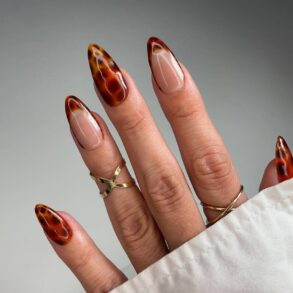
“The Russian manicure is a technique known for its detailed cuticle work and precise polish application,” says manicurist Mazz Hanna, who explains that the process involves a heavy focus on perfect cuticle work. “It is best for individuals who appreciate meticulous nail care and prefer less frequent salon visits.”
As the name suggests, the manicure originated in Russia and is also popular in Europe.
What is the process of a Russian manicure?
After stripping your nails of product (polish, gel, extensions, etc.), your tech will groom the cuticle with an electric file, a variety of small drill bits, and a tiny nail scissors. If you’ve had a dip manicure or acrylics, you’re probably pretty familiar with the use of the e-file during the removal process, but the Russian manicure takes it several steps further.
“You’re actually exfoliating the skin off the nail plate and lifting up the eponychium,” manicurist Elle Gerstein says. “The cuticle is the eponychium, based on Bolognia, our trusted dermatology textbook, but some people consider them to be different,” says Caren Campbell, MD, a board-certified dermatologist in San Francisco. “It’s semantics, especially for this topic.”
As Gerstein explains, this technique helps reduce the grow-out gap between your cuticle and polish. “It starts underneath so that you literally can get two more weeks of wear out of it [for the most part] because it’s pushed under the cuticle.”
Because the nail tech is so thoroughly cleaning and filing the nail and skin, it allows for a much tighter, more precise paint job. “The cleaner your cuticle area is, the closer your artist can apply the polish to your cuticle area, which leads to a slower grow-out and a cleaner, more polished look for an extended period of time,” says Hanna. While you can use any type of polish for a Russian manicure, Hanna says that gel is the popular option.
The rest of the manicure follows the typical process of base coat (though many Russian manicures use a specific base coat), color, and topcoat. Given the grooming is so detailed and painstaking, the entire process can take up to several hours to complete.
What are the pros and cons of the Russian manicure?
People who have tried the technique typically tout how long they can go between manicures—up to a month—and the clean, simple look it provides. “I highly recommend Russian manicures since they offer a polished, long-lasting look,” says Hanna. “By ensuring flawless prep work, the risk of chipping and lifting of the polish is minimized.”
This post was originally published on this site be sure to check out more of their content.









